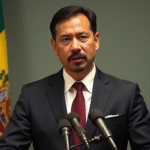Background on Key Figures and Institutions
Mexico’s economic situation has been under scrutiny as the country grapples with inflation and economic deceleration. Central to this discussion is the Banco de México (Banxico), Mexico’s central bank, and its efforts to manage inflation through monetary policy adjustments. Recently, Banxico lowered its benchmark interest rate in an attempt to stimulate economic growth and curb rising inflation.
Inflation Data: A Closer Look
The initial goal was to present a negative inflation rate during the first half of May following the interest rate reduction. However, the National Consumer Price Index (INPC) reported a 0.09% increase over the first 15 days of May, resulting in an annual inflation rate of 4.21%. This figure surpasses the tolerance range set by Banxico, raising concerns about the effectiveness of monetary policy adjustments.
- Quarterly Growth in Primary Sector: The primary sector, including agriculture and mining, experienced a 7.8% growth rate in Q1, partially offsetting declines in secondary and tertiary sectors.
- No Recession Label, Yet: The government has been actively avoiding the “recession” term, aiming to project economic stability. However, poor performance in subsequent months could change this narrative.
Electricity Subsidies and Their Impact
In certain regions, seasonal electricity tariff reductions were implemented as a subsidy during the summer heat. These lower rates contributed to a quinquennial negative rate of -18.45%. However, this positive development was overshadowed by persistent inflationary pressures in services and some goods.
Monetary Policy and Inflation Management
Banxico’s strategy to combat high inflation through monetary policy adjustments has faced challenges. While there might be room for further interest rate reductions, the central bank must carefully balance this approach to avoid undermining financial stability.
- Maintaining a Restrictive Stance: Banxico should continue to signal a cautious approach, ensuring that lower interest rates do not fuel excessive risk-taking or asset bubbles.
- Inflation Intolerance Message: Effectively communicating the commitment to keeping inflation in check is crucial for maintaining public trust and anchoring expectations.
Market Uncertainty and External Factors
Mexico’s economic outlook is further complicated by external factors, such as the behavior of U.S. bond markets and investor skepticism regarding the Trump administration’s trade and fiscal policies.
Key Questions and Answers
- What was the initial goal of the interest rate reduction? To present a negative inflation rate during the first half of May and stimulate economic growth.
- What was the reported inflation rate for the first half of May? The National Consumer Price Index (INPC) reported a 0.09% increase, resulting in an annual inflation rate of 4.21%, surpassing Banxico’s tolerance range.
- How did electricity subsidies affect inflation? Seasonal reductions in electricity tariffs contributed to a negative quinquennial rate, but persistent inflationary pressures in services and goods offset this positive development.
- What challenges does Banxico face in managing inflation? Balancing further interest rate reductions with maintaining financial stability and effectively communicating a commitment to keeping inflation in check.
- What external factors impact Mexico’s economic outlook? Uncertainty in U.S. bond markets and skepticism regarding the Trump administration’s trade and fiscal policies contribute to Mexico’s economic challenges.






